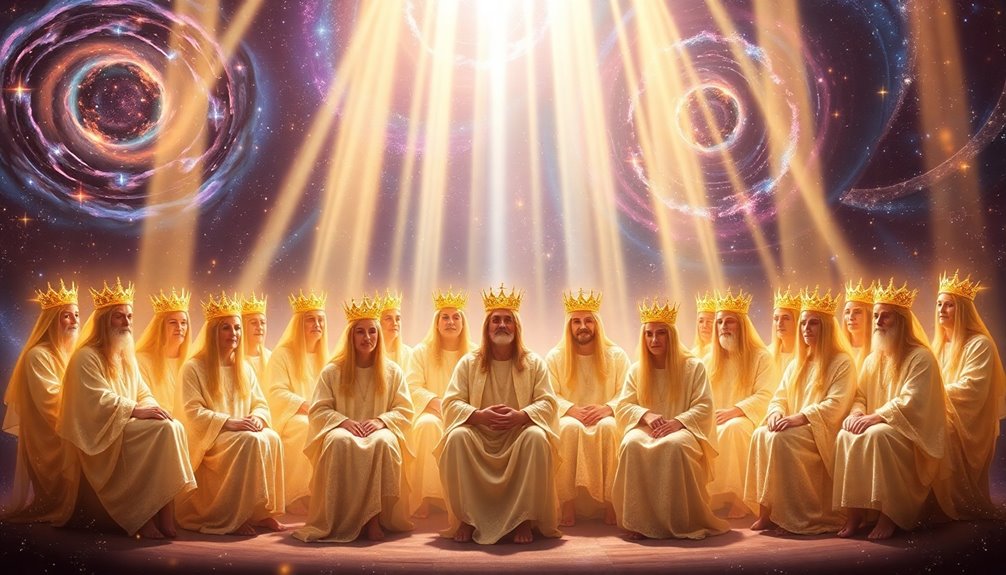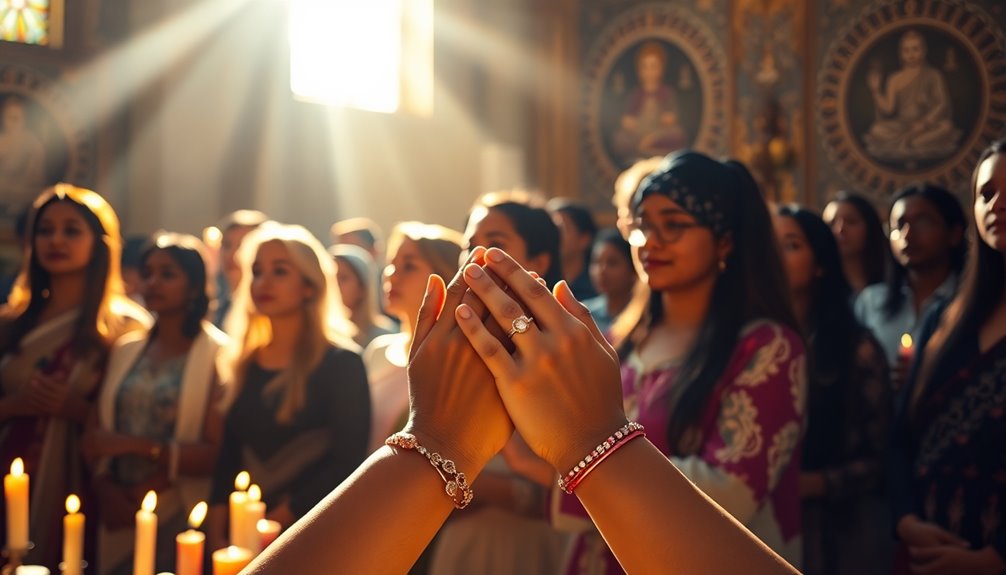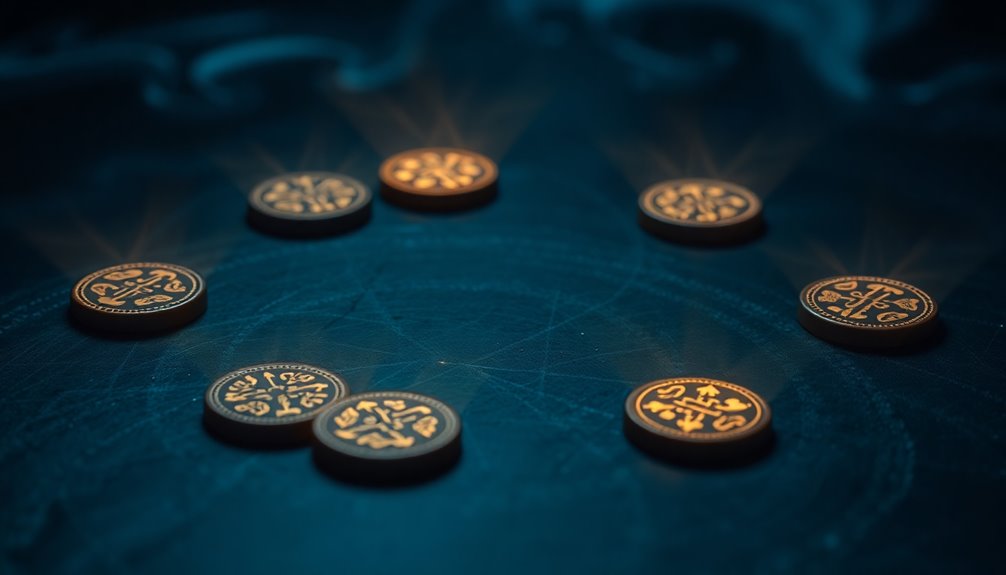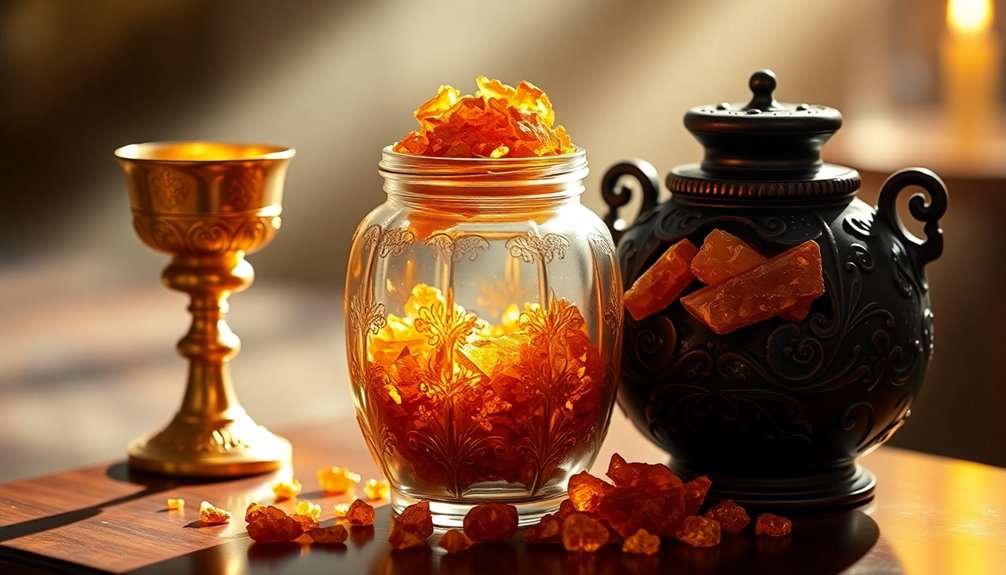The 24 elders in Revelation symbolize redeemed humanity, representing both Old and New Testament saints who worship around God's throne. Dressed in white garments and golden crowns, they embody purity and victory. These elders serve as intermediaries, offering prayers and praise to God, highlighting their authority in the heavenly court. Their number reflects completeness, bridging the 12 tribes of Israel with the 12 apostles to showcase unity. While often mistakenly viewed as angelic beings, they truly represent the faithful redeemed. If you're curious about their influence in worship and authority, you'll discover intriguing insights ahead.
Key Takeaways
- The 24 elders are seated around God's throne in Revelation, symbolizing authority and governance in heavenly worship.
- They are adorned in white garments and golden crowns, representing purity, victory, and the honor of redeemed humanity.
- The number 24 signifies the unity of both Old and New Testament saints, reflecting God's covenant across generations.
- They serve as intermediaries, offering prayers and guiding believers, emphasizing their role in connecting humanity with the divine.
- The elders reflect Jewish priestly traditions, mirroring the structured worship established by King David and showcasing continuity in God's covenant.
Introduction

The 24 elders, seated around God's throne in Revelation, play a crucial role in the heavenly realm. These figures are often depicted in white garments and golden crowns, symbolizing their purity, righteousness, and victory over sin. Their presence suggests authority and governance in the divine council, reflecting a structure of worship and reverence before God.
You might wonder about their identity. The debate continues, with interpretations suggesting they represent the Church, the 12 tribes of Israel, and the 12 apostles. Regardless of their specific identities, their purpose is clear: they worship God and offer prayers, acting as intermediaries between the divine and humanity.
The number 24 holds significance, symbolizing completeness and highlighting the unity of God's plan throughout biblical history. It encompasses both the Old and New Testament saints, reinforcing the idea that God's covenant extends across generations.
In Revelation, the 24 elders remind you of the enduring connection between the faithful and God's ultimate authority. Their role emphasizes the importance of worship and obedience in the heavenly realm, inviting you to reflect on your own relationship with the divine.
Scriptural Basis for Elders

To understand the significance of the 24 elders, you'll want to look closely at key Bible references that outline their role and identity.
The primary passages, especially in Revelation, highlight their authority and participation in worship.
Additionally, secondary references can provide further insight into their representation of God's faithful people throughout history.
Primary Bible References
Introduced in Revelation 4:4, the 24 elders are seated around God's throne, adorned in white robes and golden crowns, symbolizing their righteousness and victory. These elders play a crucial role in the heavenly worship environment.
As described in Revelation 4:9-10, they give glory and honor to God, showcasing their authority and deep reverence. Their actions reflect not just submission but active participation in worship.
In Revelation 5:5, you see that the elders have individual voices, emphasizing their unique identities within the collective. This personal touch adds depth to their worship, as they blend their voices into the heavenly choir.
Moreover, Revelation 7:13 reveals an interaction between one elder and John, where the elder provides insight about the redeemed multitude. This interaction further illustrates their role as intermediaries, guiding believers in understanding divine mysteries.
The significance of the number 24 may also imply completeness and unity, representing both the 12 tribes of Israel and the 12 apostles. Together, they embody a full spectrum of worship and authority in the heavenly realm, underscoring the importance of these elders in Revelation.
Secondary Bible References
Understanding the role of the 24 elders in Revelation also involves examining secondary Bible references that add depth to their significance. In Revelation 4:4, you see the 24 elders seated on thrones, clothed in white garments and golden crowns, which symbolize their authority and righteousness. This imagery emphasizes their exalted position in heaven.
In Revelation 5:8, the elders hold golden bowls filled with incense, representing the prayers of God's people. This act highlights their intercessory role, showing that they actively participate in presenting believers' petitions before God.
Furthermore, Revelation 5:5 illustrates one elder engaging John, which signifies their individuality and involvement in the heavenly narrative.
Their presence in Revelation 7:13 reinforces their role as representatives of the redeemed community, bridging the gap between God's people and His throne.
The number 24 likely symbolizes completeness, reflecting both the 12 tribes of Israel and the 12 apostles. This dual representation underscores the unity of God's people across the Old and New Testaments, enhancing our understanding of the 24 elders' significance in Revelation.
Jewish Priestly Traditions Influence

How do Jewish priestly traditions shape our understanding of the 24 elders in Revelation? The 24 elders can be seen as a reflection of the 24 divisions of priests established by King David, as noted in 1 Chronicles 24. This connection emphasizes a structured approach to worship, mirroring the organized service of priests in the temple. Each division had designated weeks for service, highlighting the elders' role in maintaining order in God's heavenly presence.
The elders wear garments resembling the priestly robes, symbolizing their function in interceding for the people and presenting prayers before God. Their act of holding golden bowls filled with incense, as described in Revelation 5:8, draws from the Levitical priests' practice of offering incense during worship rituals.
Additionally, the significance of the number 24 resonates with the twelve tribes of Israel and the twelve apostles, suggesting a continuity of God's covenant. This connection reinforces the fulfillment of priestly duties across both the Old and New Testaments, positioning the 24 elders as vital figures in God's overarching plan for worship and intercession.
Symbolism of Heavenly Authority
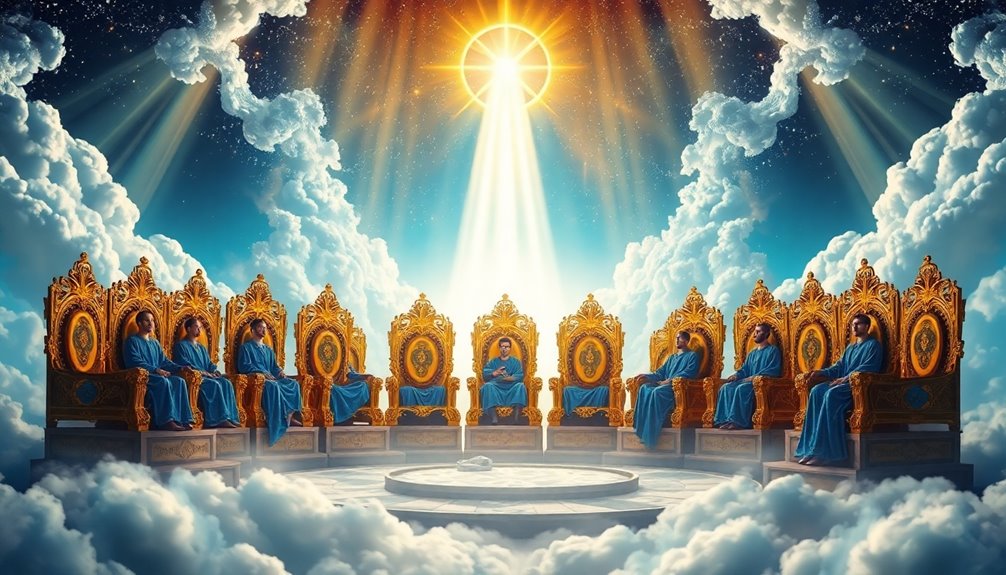
In the grand narrative of Revelation, the 24 elders seated on thrones embody heavenly authority and governance within God's divine council. Their presence signifies a structured worship environment where divine order prevails.
Clad in white robes, the elders represent purity and righteousness, reflecting their role as intermediaries between God and His people. The crowns of gold they wear symbolize the victory and authority bestowed upon them, marking their status as representatives of the redeemed.
The number 24 carries deep significance, representing both the 12 tribes of Israel and the 12 apostles, which illustrates the unity of the Old and New Covenants. This completeness emphasizes God's overarching plan for humanity.
As you observe the elders throughout Revelation, you'll notice their active participation in worship, including offering prayers in golden bowls. This act underscores their role in facilitating communication between the divine and earthly realms, reinforcing their heavenly authority.
Their consistent involvement in worship scenes highlights the acknowledgment of God's sovereignty and divine order in the heavenly realm. Thus, the 24 elders serve as a powerful representation of God's governance, illustrating His authority and the structure of celestial worship.
Misunderstandings About Their Identity
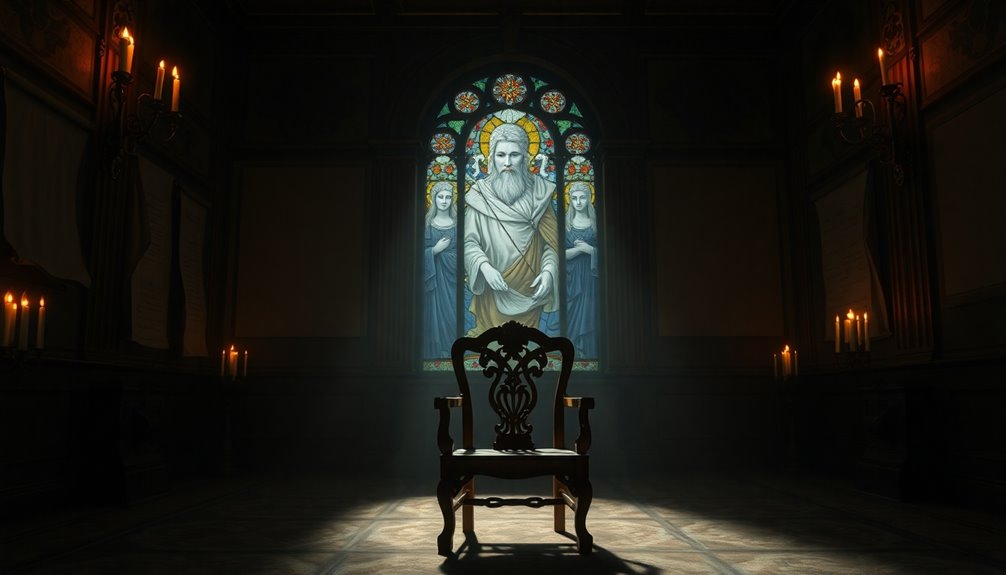
You might be surprised to learn that many common misconceptions surround the identity of the 24 elders in Revelation.
While some see them as angelic beings or merely symbolic figures, there's significant disagreement on their true role and representation.
Let's unpack these misunderstandings to clarify who these elders really are.
Debunk Common Misconceptions
Many people hold misconceptions about the identity of the 24 elders in Revelation, often mislabeling them as angels. In reality, these elders represent redeemed humanity, specifically the Church. They wear white garments and crowns, symbols of righteousness and victory, indicating their status as those who've triumphed through Christ.
It's a common mistake to think the twenty-four elders represent Israel as a nation, but their identity is firmly tied to the Church, which reigns with Christ in heaven. Some interpretations even suggest the elders are merely symbolic, but Revelation describes them as actual beings engaging in worship, affirming their real presence in the vision.
The number 24 can also confuse; it symbolizes completeness and unity, representing both the 12 tribes of Israel and the 12 apostles. This connection illustrates the harmony between the Old and New Testaments.
Lastly, misconceptions often overlook the elders' role in intercession. They hold golden bowls filled with the prayers of God's people, showcasing their active participation in divine worship rather than a passive symbolic role. Understanding these facts helps clarify who the 24 elders truly are in Revelation.
Disagreement on Their Identity
Disagreement surrounds the identity of the 24 elders in Revelation, leading to a variety of interpretations. Some argue that the 24 elders symbolize the Church, while others see them as representing the 12 tribes of Israel alongside the 12 apostles.
A common misunderstanding is that these elders are angelic beings. However, the biblical description points to them being redeemed humans, as evidenced by their white garments and golden crowns.
Their roles in worship and prayer further highlight their humanity. The elders present the prayers of the saints before God, a function that distinctly separates them from angelic roles.
Some misinterpret their seating on thrones as a sign of divine authority, which typically belongs to God or angels, overlooking the fact that these thrones symbolize the honor given to redeemed believers.
The lack of specific names for the elders in Scripture adds to the confusion, allowing various theories about their identity to flourish.
Instead of viewing them as individual figures, it's essential to recognize the 24 elders as a collective representation of the faithful, embodying the worship and prayers of the saints in God's presence.
Worship Practices in Congregations
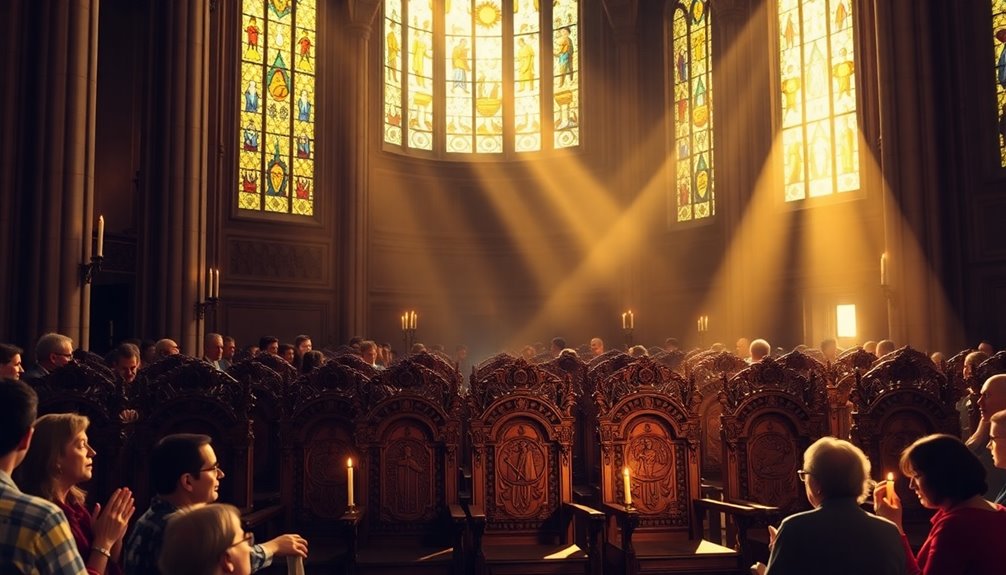
In your daily life, worship practices can shape how you connect with your faith and community.
Understanding how congregational leadership guides these practices helps you appreciate the variety of worship styles available.
Let's explore how singing, prayer, and sacraments play a role in enriching your spiritual experience.
Worship in Daily Life
Worship in congregational settings is a vibrant expression of faith that brings people together in shared devotion to God. In these gatherings, you'll often experience singing hymns and contemporary songs, creating a communal atmosphere that deepens your connection with others and God.
Prayer stands at the heart of worship, where you join fellow congregants in seeking divine guidance, interceding for those in need, and expressing gratitude.
The observance of sacraments like baptism and communion serves as a tangible reflection of your faith, offering a means of grace that nourishes your spiritual life. Additionally, the reading and preaching of Scripture are integral components, providing you with essential insights into God's Word that encourage growth in your understanding.
Worship doesn't stop within church walls; it extends into daily life through acts of service and outreach. These actions demonstrate your faith in practice, reminding you that worship isn't just an event but a lifestyle.
Congregational Leadership Insights
As you engage in worship practices within your congregation, it's valuable to draw inspiration from the 24 elders in Revelation. These elders exemplify heartfelt praise and worship, highlighting the significance of corporate worship. Their white garments and golden crowns symbolize purity and victory, encouraging you to approach worship with reverence and a celebration of God's grace.
The elders holding golden bowls full of incense, representing the prayers of the saints, emphasizes the importance of prayer in your worship services. This communal aspect of lifting prayers collectively can strengthen your congregation's bond and spiritual growth.
Additionally, the elders' participation in singing a new song before the Lamb fosters creativity and renewal in worship practices, reminding you to embrace fresh expressions of worship.
Moreover, the elders' authority, seated on thrones, serves as a crucial reminder for congregational leadership. It urges church leaders to guide worship with biblical principles and integrity, reflecting a commitment to God's sovereign rule. Understanding the significance of emotional regulation in worship can also enhance the overall experience for both leaders and congregants.
Heavenly Authority's Significance Highlighted
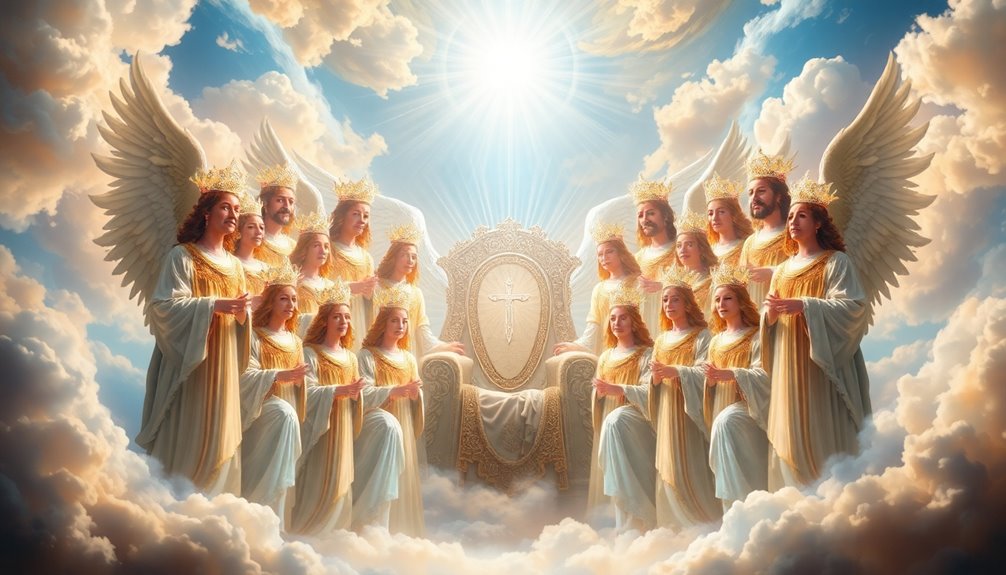
The 24 elders seated around God's throne illustrate a profound significance of heavenly authority. Their presence emphasizes governance in the heavenly realm, showcasing a structured order where each elder plays a vital role. Dressed in white garments that symbolize purity, they reflect the righteousness expected in God's presence, while their golden crowns signify their victorious status as redeemed believers.
In worship, the elders actively engage in acts of reverence, bridging the gap between God and His people. This role underscores the importance of divine order within heaven and highlights their authority as intermediaries.
The number 24 is particularly meaningful, representing the unity of Old and New Testament believers—incorporating the 12 tribes of Israel and the 12 apostles.
Their prayers and worship acts emphasize the authority they hold in the heavenly court, illustrating a collective expression of faith that connects earthly believers to heavenly governance.
As you reflect on the 24 elders, consider how their roles not only represent heavenly authority but also encourage you to embrace purity and participate in worship within your own faith community.
Additional Resources
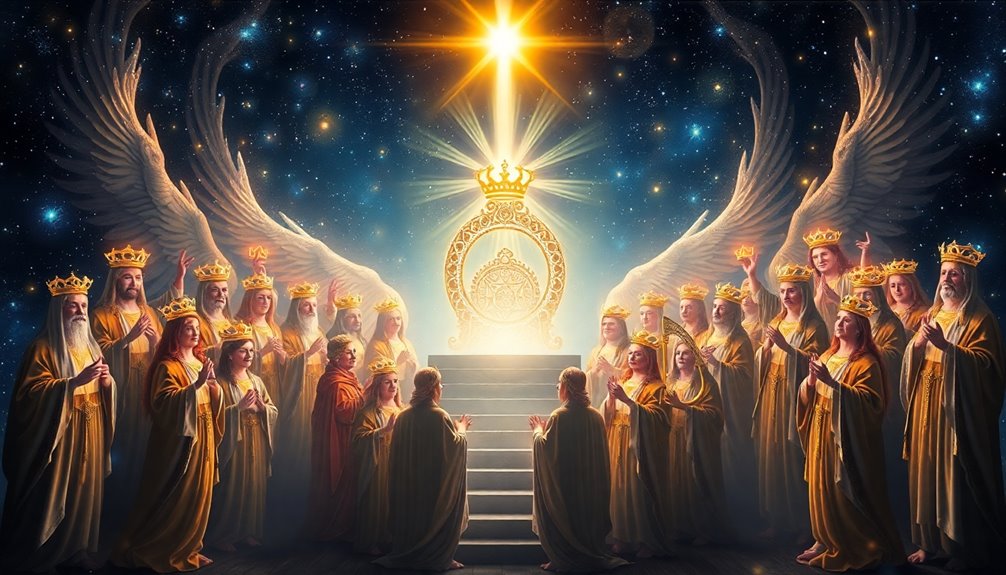
Exploring the topic of the 24 elders can deepen your understanding of their significance in the Book of Revelation. To grasp their role better, consider studying the context of Revelation 4:4, where the twenty-four elders fell before the throne, wearing white garments and golden crowns. This imagery reflects their authority and righteousness.
You'll find it enlightening to explore interpretations that suggest these elders represent the 12 tribes of Israel and the 12 apostles, symbolizing the raptured Church. Their presence throughout Revelation serves as a reminder of unity among God's people across different eras.
For a more in-depth understanding, resources like "Israel and the Church" by Amir Tsarfati can shed light on the theological implications surrounding the elders and their worship throughout Revelation.
The significance of the number 24 highlights completeness, emphasizing the unity of believers in God's divine plan.
Frequently Asked Questions
What Do the 24 Elders in Revelation Represent?
The 24 elders in Revelation represent a significant aspect of divine governance and the community of believers. They symbolize the unity of God's people, bridging both the Old and New Testaments.
Their white garments highlight righteousness, while the golden crowns signify victory in faith. By holding bowls of incense, they actively intercede for the saints, emphasizing their role in worship and prayer, showcasing the ongoing connection between heaven and the faithful on earth.
What Are the Four Living Creatures in the 24 Elders?
The four living creatures in Revelation are majestic beings that surround God's throne, continually worshiping Him.
Each creature has a unique appearance: one resembles a lion, another an ox, one has a human face, and the last looks like a flying eagle.
With six wings and covered in eyes, they symbolize vigilance and awareness of God's glory.
Their role emphasizes the heavenly worship alongside the 24 elders, reflecting God's sovereignty over all creation.
What Did the Bible Say About the 24 Elders?
The Bible describes the 24 elders in Revelation as seated around God's throne, wearing white robes and golden crowns, symbolizing their purity and victory.
They hold golden bowls filled with incense, representing the prayers of God's people.
Throughout Revelation, they engage in constant worship, highlighting their role in glorifying God and participating in heavenly governance.
Their presence reflects the connection between the faithful of both the Old and New Testaments.
Who Are the Elders in the Bible?
When you read about the elders in the Bible, you find figures of authority and wisdom. They often represent leaders or respected individuals within the community, guiding others in faith and worship.
In various scriptures, elders provide counsel, help maintain order, and ensure the spiritual well-being of their people. Their role emphasizes the importance of guidance and accountability, reflecting God's design for leadership among His followers throughout different biblical narratives.

